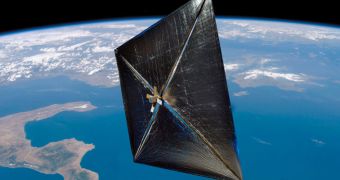NASA has issued a call for amateur ham operators and astronomers to aid it in listening to the first signals coming in from a satellite that was launched on November 20, 2010. The spacecraft contained one of the few solar sail demonstrators produced in the United States.
The Fast, Affordable, Science and Technology Satellite (FASTSAT) launched from the Kodiak Launch Complex in Kodiak, Alaska last year, and one of the components in its payload was the NanoSail-D micro-satellite, which hosts a solar sail.
This technology works by allowing a spacecraft to be propelled through space using the power of light alone. This is not to be confused with solar panel technology, which converts photons to electrons.
A solar sail is basically a large piece of a very special fabric, that is tremendously-thin, and also covers a very large surface. When exposed to sunlight, in other words to the photon stream that produces it, it swells, and then propels whatever craft it is installed on.
The reason it's called a sail is because it looks and acts precisely how a regular cell does on a ship roaming Earth's seas. The technology has been demonstrated last year by Japan, which launched the IKAROS spacecraft together with the Akatsuki Venus orbiter.
Even though FASTSAT was launched months ago, it was not yet NanoSail-D's time to be ejected. But the event occurred spontaneously on Wednesday, January 19. Mission controllers discovered it by accident while looking through telemetry data sent back by the carrier satellite.
The separation was confirmed 11:30 am EST (1630 GMT) by engineers at the Huntsville, Alabama-based Marshall Space Flight Center (MSFC). Ground-based satellite tracking assets also confirmed the FASTSAT telemetry data.
NASA is currently engaged in an all-out effort to tune in on the radio signals the NanoSail-D spacecraft is supposed to emit, and this is why it is calling for amateur help. The beacon signal can be found at 437.270 MHz.
“After ejection, a timer within NanoSail-D begins a three-day countdown as the satellite orbits the Earth. Once the timer reaches zero, four booms will quickly deploy and the NanoSail-D sail will start to unfold to a 100-square-foot polymer sail,” NASA says in a statement.
“This is great news for our team. We’re anxious to hear the beacon which tells us that NanoSail-D is healthy and operating as planned,” says the MSFC NanoSail-D principal investigator Dean Alhornand.
“The science team is hopeful to see that NanoSail-D is operational and will be able to unfurl its solar sail,” adds the official, who is also an aerospace engineer at the Center.

 14 DAY TRIAL //
14 DAY TRIAL //